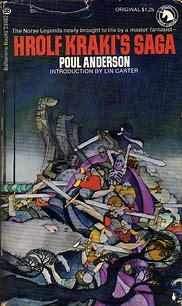According to Geoffrey of Monmouth, King Arthur Pendragon of Britain conquered Ireland. According to Irish mythology, the hero Fionn MacCuhaill defeated an invasion by Arthur, son of Britt. Thus, Arthur "crosses over" from British to Irish mythology, like Superman appearing in a Captain Marvel comic. Alan Moore colourfully explains the concept of comic book crossovers:
"For those more familiar with conventional literature, try to imagine Dr Frankenstein kidnapping one of the protagonists of Little Women for his medical experiments, only to find himself subject to the scrutiny of a team-up between Sherlock Holmes and Hercule Poirot." (1)
Moore himself wrote a comic book script in which Jules Vernes' Nautilus fights HG Wells' Martians in the Thames.
Poul Anderson, faithfully following his sources for Hrolf Kraki's Saga (New York, 1973), presents us with a mythological crossover before we have realised that it is happening. When he has got us used to the idea that the brothers Hroar and Helgi jointly ruled as kings in Denmark, he tells us that Hroar erected a hall of which "...men said no goodlier home had been in the North since Odin dwelt on earth." (p. 64) Because of "...mighty antlers..." on its beam-ends, the hall was called Hart, which meant nothing to me when I read it. (p. 64)
Next, however, a monster hight Grendel terrorises the hall until stopped by "...Bjovulf of Gotaland, the man that in England they call Beowulf." (p. 65) Then we realise that, with a change of vowels, "Hart" becomes "Heorot." Google confirms that Hroogar (who must be Hroar) was lord in Heorot which means "Hall of the Hart." The google article even begins, "It has been suggested that Beowulf and Hrolf Kraki be merged into this article or section. Discuss."
Suddenly, Hrolf Kraki, of whom I had not heard except in this book by Anderson, assumes a greater significance. The story of Beowulf is summarized on pages 65 and 66 of the Saga.
(1) Moore Alan, Introduction IN Alan Moore, Stephen Bissette, John Totleben, Saga Of The Swamp Thing, New York, 1987, pp. v-ix AT p. vii.

No comments:
Post a Comment